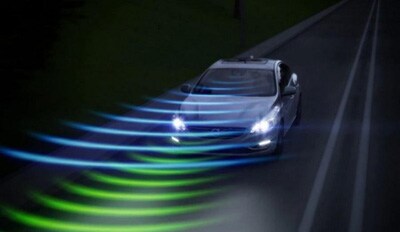"Volvo" and "safety" are synonymous in regard to the automotive world.
The Swedish automaker's safety roots date all the way back to 1958 when the seat belt as we know it today originated as a three-point belt. Less than a decade later, the automaker developed the world's first rear-facing child car seat. Fast forward to 1998, when it was the first to install a head airbag. There's also the whiplash protection system, designed to protect passengers from experiencing the common post-accident after effect. Fittingly, many of Volvo's vehicle models have routinely appeared on various "Safe Car" lists.
Yes, Volvo is serious about safety. So it should come as no surprise that the automaker has introduced a new safety feature, which it debuted at the 2013 Geneva Motor Show. However, this safety feature involves headlights. Specifically, this headlight feature, which the automaker calls "Active High Beam" technology, allows Volvo drivers to drive at night with their high beam headlights (aka "brights") on at all times.

We know what you're thinking. Typically, drivers use their brights in rural night driving conditions or when there's an absence of other cars on the road due to the fact that high beams are distracting and could potentially also be a safety hazard to others on the road with you. It's typically why high beams are used sparingly, because it's commonplace for drivers to manually toggle them on and off when oncoming traffic is detected.
So how does Volvo's Active High Beam technology allow drivers to always have their brights on? The lights work together with small cameras that are installed on the rearview mirrors in a forward facing fashion. It's these mirrors that work to detect oncoming traffic on the road ahead (i.e., car, truck, motorcycle, biker, etc). When another car is detected by the camera, the headlights automatically adjust to block a portion of the high beam light. It just so happens that the portion of the light that is blocked is the portion of light that is distracting to other drivers, so it's a win-win addition - Volvo drivers will be able to see more and stay safe and oncoming traffic won't be impaired by the would-be bright light of the high beams. Plus, there's no manual toggling involved, which is another nice bonus.
The Swedish auto company says the cameras are accurate up to 1.5 degrees. What's more is that it works at speeds as slow as 1 mph. You might have seem a similar technology recently introduced by Audi known as "matrix beam lighting." This is Volvo's spin on this innovative lighting concept.
It's a neat innovation that turned heads at the Geneva Motor show. But for now unfortunately, Europe is among the few areas that the technology will be available in. That's because the United States abides by the Federal Motor Vehicle Safety Standard, which states that headlights aren't permitted to emit light in any sort of dynamic way. Active High Beam fits into that definition. So while the U.S. will have to wait until the law is revised or until another law replaces it, Active High Beam technology will be available on select Volvo models beginning in the spring of 2013, specifically the S60, V60 and XC60.
First seat belts, then baby seats, head airbags and whiplash protection technology. Now Volvo has taken safety to its headlights. Who knows what the automaker has up its sleeve next.